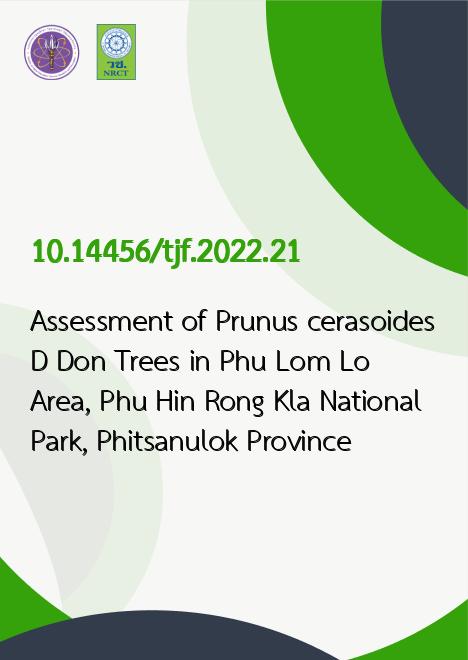
|
Assessment of Prunus cerasoides D. Don Trees in Phu Lom Lo Area, Phu Hin Rong Kla National Park, Phitsanulok Province |
|---|---|
| รหัสดีโอไอ | |
| Creator | Adisorn Khunwichai |
| Title | Assessment of Prunus cerasoides D. Don Trees in Phu Lom Lo Area, Phu Hin Rong Kla National Park, Phitsanulok Province |
| Contributor | Teeka Yotapakdee, Monton Norsangsri, Torlarp Kamyo |
| Publisher | Kasetsart University |
| Publication Year | 2565 |
| Journal Title | Thai Journal of Forestry |
| Journal Vol. | 41 |
| Journal No. | 1 |
| Page no. | 102-115 |
| Keyword | Assessment, Prunus cerasoides D. Don, Phu Lom Lo, Phu Hin Rong Kla National Park, Phitsanulok Province |
| URL Website | https://li01.tci-thaijo.org/index.php/tjf/article/view/253873 |
| Website title | Thai Journal of Forestry |
| ISSN | 2730-2180 |
| Abstract | This research aimed to survey and assessed the Prunus cerasoides D. Don trees growing in Phu Lom Lo, Phu Hin Rong Kla National Park, Phitsanulok province. The endeavor was to establish a basic database of trees to be used by the respective department during planning of maintenance activities of trees. According to the study, tree assessment methods were chosen to assess conditions of P. cerasoides in Phu Lom Lo. Data field were collected by applying and modifying from problematic conditions in different parts of trees and to assess the risk that will affect the damage if P. cerasoides fell or death by using ISA (International Society Arborist) basic tree assessment criteria. The survey results show that the number of Prunus cerasoides D. Don trees in the area were 19,365, with 398 trees having issues with their trunk and branches, as assessed according to the criteria. The trunk assessment showed that 6 trees were at extreme risk (1.51 percent), 63 trees at high risk (15.83 percent), 137 trees at medium risk (34.42 percent), and 192 trees were at low risk (48.24 percent). The branch assessment found no trees at extreme or high risk, but there were 3 trees at medium risk (18.75 percent) and 13 trees at low risk (81.25 percent). The main problem afflicting the trees at risk were missing bark, cankers/galls, cavity, prolific ivy, decay, leaning in the trunk, which was likely to cause future damage. Therefore, there should be an urgent management plan in extreme risk first with consult the professional or arborist. |